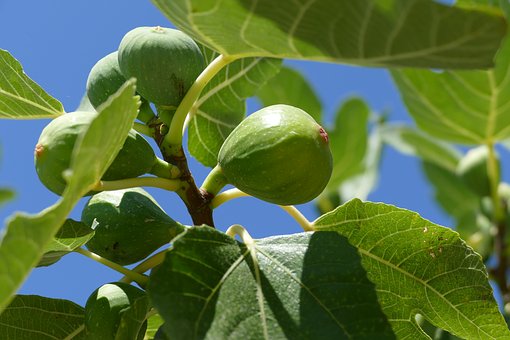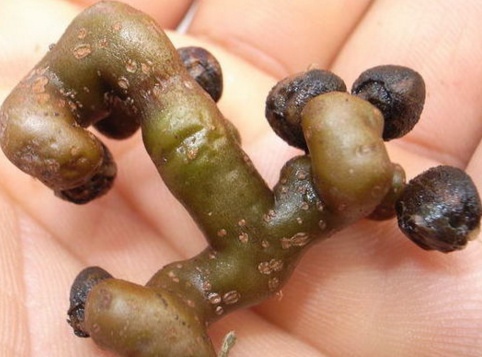Introduction to the cutting methods of 10 common potted plants, such as figs, roses, sweet-scented osmanthus, etc. Pick up a branch and raise a basin.
Usually when I walk and play, I see the bright flowers and luxuriant grass next to them. I wish I could move them all home and decorate the house into a world of flowers and plants. In fact, we can use the method of cutting to "move" the flowers and plants we usually see on the side of the road. What should we do? The following is to introduce the cutting methods of figs, roses, sweet-scented osmanthus and other common potted plants, pick up a branch to raise potted flowers.
Figs
Recently, figs are on the market. They are delicious, but expensive, and difficult to store. They are not very fresh on the market. Wouldn't it be cool if you could grow a fig at home and eat it when you pick it? When not eating fruit, the leaves of figs can also decorate the home, which is more beautiful than common foliage plants.

Cutting method
1. Figs can be cut all year round (except in the northern winter). When cutting, cut off sturdy and pest-free branches, about 15-20 cm per branch, with 2-3 leaves on top.
two。 Soak the cut branches in clean water for 2-3 hours, wash the dirt off the surface, and then soak the lower end of the branches in a rooting agent solution for 6-10 minutes.
3. The highest success rate of fig cuttage is the river sand, which had better be rinsed or exposed to the sun with carbendazim before use.
4. Find a plastic bottle, cut off the upper part, leave only half, and put a few holes in the bottom of the bottle, fill the lower part of the plastic bottle with river sand, water it thoroughly.
5. Poke several small holes in the river sand with your fingers, insert the lower part of the treated fig branch into the small hole, then compact it slightly with the sand around the hole, and finally put it on the east and west balcony with astigmatism and ventilation.
6. Now the high temperature takes root quickly, and it will take about 10-20 days to take root. We can clearly see the white root system through the wall of the plastic bottle.
7. Cut the plastic bottle, take the rooted figs with the original soil, and transplant them into a deep flowerpot intact. Pay attention to ensure adequate light and moisture, see that the leaves are a little wilted, water through, but do not accumulate water.
Second, rose
Cutting method
1. The easiest part of rose cutting is, of course, the branches after flowering, the residual flowers and the 2 leaves below can not be used, cut off.
two。 Cut the branch into several small segments, the upper part is cut flat above the bud point, and the lower part is about 0.5-1 cm away from the bud point. The incision is smooth and cannot be rough. Tip: be sure to use a very sharp blade or scissors and bake and disinfect with a lighter in advance.
3. Cut off the excess leaves on the branches, leaving only 1-2 leaves in each section, and cut off half of each leaf to reduce water evaporation, otherwise the branches are prone to dehydration and loss of activity.
4. Outdoor branches, inevitably with some bacteria to affect survival, so all the treated branches need to be soaked in carbendazim solution for 10-15 minutes, disinfection and sterilization.
5. After disinfecting the branches, we dilute the rooting agent with water, then mix it into the bottom ash (plant ash) and stir it into a paste, apply it to the oblique incision at the bottom of the branch, and disinfect it to promote rooting.
6. Cut the treated branches into the soaked soil in advance, and the soil can use vermiculite, perlite, peat soil, fine sand, rice husk carbon, etc., one principle is clean and breathable, there are no germs, and many people do not do a good job of disinfection when cutting rose.
7. After cutting, spray water on the leaves to moisturize, and then put them in a cool and ventilated place, do not expose to the sun, spray water on the leaves 1-2 times a day, the soil remains slightly moist, you can put a tray in the basin bottom, add water to the tray, and let the soil absorb water automatically from the vents at the bottom of the basin. You can also put them in large plastic buckets to moisturize.
8. Indoor cutting, the temperature is not higher than 28 degrees, not less than 20 degrees, about 15 days can take root.
9. After taking root, you can transplant it into a big pot!
Third, triangular plum
When my friends in the south see the triangular plum blossom wall by the roadside, do they want to move back home? Don't envy, learn the following cutting methods, you can also have a triangular plum blossom wall, hurry up and take action.
Cutting method
1. Prepare some porous soil before cutting. you can use peat soil, mixed with vermiculite and river sand.
two。 Select healthy triangular plum branches for more than one year, cut into several small segments, each section is about 7-10 cm, with 1-2 buds, most of the leaves are removed, leaving only 2-3 pieces, to reduce water evaporation.
3. Dip the lower end of the triangular plum branch with some water, then dip it into the rooting powder, then insert the lower end of the branch into the soil and pour it thoroughly.
4. After cutting, cover the top of the flowerpot with a layer of cling film and put it in a cool and ventilated place. now it is hot, you can make a few small holes in the film to breathe. After about 2 weeks, the triangulated plum branches will take root and transplant into the flowerpot after rooting.
Wisteria wisteria
I have heard a friend say that he wants to plant wisteria more than once. In fact, it is not difficult to cut wisteria. If you see a neighbor, you can ask for a branch to cut.
Cutting method
1. Cut out sturdy and healthy 1-2-year-old wisteria strips, each cut into cuttings of about 15 centimeters.
two。 If there are leaves and new buds on the cuttings, cut them off to prevent nutrient consumption, then soak the cuttings in carbendazim solution for 5-10 minutes, and then soak the lower part in rooting solution for about 20-30 minutes.
3. Soaked branches, the bottom directly into the soil, the soil does not require much, clean without germs, it is best to spread out in the sun for 2 days in advance.
4. The upper cut of the branch is wrapped in a plastic bag to avoid water evaporation and affect survival.
5. Put the cutting flowerpot in a cool and ventilated place, do not expose yourself to the sun, keep the soil slightly moist, and quickly pinch off the buds before taking root.
6. Wisteria takes root slowly and takes about a month. You must be patient. After taking root, you can let it sprout, see the sun, and grow very fast.
5. Osmanthus fragrans
Sweet-scented osmanthus smells delicious, and it is also a hot flower, but it is a little expensive, but we can make use of those sweet-scented osmanthus trees on the side of the road, sometimes scrape off branches and hurry to pick them up and go home.
Cutting method
1. The cutting branches of sweet-scented osmanthus are preferably the more robust woody branches that were born in the same year.
two。 Sweet-scented osmanthus cutting soil, you can use peat soil, mixed with a handful of sand, you can also use vermiculite, water conservation and ventilation at the same time.
3. Cut the branches of sweet-scented osmanthus into cuttings 10-20 cm long, leaving 2-3 leaves at the upper end, the lower leaves removed, and the cut into a horseshoe shape.
4. The branch of sweet-scented osmanthus is inserted into the soil according to the plant distance of 6cm × 6cm, and the part of the branch is about 2 × 3 of the length of the branch and watered thoroughly.
5. Put the cuttings in a place where astigmatism is ventilated, cover with film, and often spray water to increase humidity.
6. Usually one or so, the branches can take root.
VI. Cuckoo
Rhododendron is also a very common flower in the national green belt, there are many varieties, and the blooming season is different, if there is a favorite variety, you might as well wait for the greening master to prune, pick up a branch according to the cutting method, go home and try cutting!
Cutting method
1. The cutting of rhododendron can be carried out basically in one year, and the branch activity is the strongest in August-September and April-May, and the temperature is suitable, and the cutting survival rate is very high.
two。 Cuckoo cutting soil is generally mixed according to peat soil: pastoral soil: coconut bran = 4:3:3. Before formal cutting, the soil is watered thoroughly, and then several small holes are inserted on the soil surface.
3. Use sharp scissors to cut the sturdy branches of rhododendrons that are disease-free and pest-free. The branches are about half a year to a year old.
Cut the branches into several cuttings, about 8 cm each, with all the lower leaves cut off and half of the upper leaves cut off. Soak the lower part of the pruned branches in rooting powder solution for about 5 minutes.
4. Insert the cuckoo branch into the hole, compact it slightly, then pour it into water once, and spray it with carbendazim solution to disinfect and sterilize.
5. After cutting, spray more water to moisturize, cool astigmatism, do not direct.
6. Keep the soil slightly moist, spray water quickly when the soil is a little dry, about 3-4 weeks, the cuckoo will take root! After taking root, just transplant it into a flowerpot and raise it.
Camellia
Camellias are big and beautiful camellias, which are also liked by many people. There is a variety control around him. He will exchange branches and cuttings with others as soon as he sees the varieties he does not have, and he will not stop until he achieves his goal.
Cutting method
1. The camellia branches that grow within half a year are the easiest to survive, the buds between the leaves are more full, and there are no diseases and insect pests.
two。 Cut the branches of camellias into small segments, remove the bottom leaves and keep 2 leaves at the top, and cut off half of the two leaves. The trimmed branches are soaked in an aqueous solution of carbendazim: water = 1: 1: 1000 for 5-10 minutes.
3. To cut the substrate of camellias, you can choose sand or perlite, put the sand into a basin, pour water thoroughly, and poke several small holes with a stick.
4. Insert the branches into the hole, bury the soil, compact, water once, then cover with a layer of cling film, put it in a cool and ventilated place, open full at noon every day, and spray moisturizing once. Can take root in a few weeks, after rooting, transplant into the flowerpot normal maintenance on it.
8. Hydrangea
Hydrangea is very common on the road in the north, it opens a large area, especially spectacular! . I can't help taking pictures every time I pass by. In fact, now that hydrangea has just failed, it is a good time for cutting, so let's make use of it quickly!
Cutting method
1. Use a sharp knife to cut off the flowering hydrangea branches, be sure to be fast and ruthless, 45 degrees oblique cut, so that the incision as smooth as possible.
two。 Leave the 2 leaves above the oblique cut, and then cut flat above the blade.
3. Cut the two leaves in half to reduce water evaporation.
4. Insert the treated branches in loose and breathable sandy soil, pour carbendazim solution once to moisturize, and spray water on the soil surface 1-2 times a day.
5. Keep the soil surface slightly moist, about 15-20 days, the branches can take root, oh, after rooting and transplant into a large basin.
9. Hibiscus
Hibiscus is a very common flower in both the south and the north. It has a large number of flowers, looks good, has a long flowering period and, more importantly, is very leather and sturdy. The south can also blossom all the year round. Today, let's take hibiscus as an example to introduce cutting methods.
Cutting method
1. The sturdy branches of hibiscus are cut for less than half a year to a year.
two。 Cut the hibiscus branches short, each section about 5-8 cm, bubble carbendazim solution about 2-5 minutes, and then take out to dry.
3. Prepare perlite and vermiculite, mix at 1:1, then put into a disposable paper cup and pour thoroughly.
4. Insert the branches into the soil and put them in a cool and ventilated place without exposure to the sun.
5. In a few weeks, the little hibiscus will take root!
6. In addition to using soil cuttings, you can also use foam water to take root, which is relatively easy.
7. After taking root, the small hibiscus can be transplanted into a flowerpot for maintenance. After that, put it in a place with good light, receive enough light and keep it ventilated.
Catharanthus roseus
Catharanthus roseus is also a common flower in the green belt, and it is very easy to cut, and it is also skinny when raised.
Cutting method
1. Cut off the healthy twigs of Catharanthus roseus, about 5-7 cm. If there are no diseases and insect pests, cut off half of the leaves.
two。 Find a plastic bottle, buckle a square hole in the middle of the bottle, fill it with vermiculite, pour it thoroughly, and then insert the rosewood into the vermiculite.
3. Put the cuttings of Catharanthus roseus in a place with astigmatism and ventilation, and often spray water to moisturize.
4. Catharanthus roseus can produce white roots in about 10-15 days! After taking root, transplant to a large pot to raise it!
Rose, triangular plum and camellias are all very good potted flowers with high ornamental value. The above introduces the cutting methods of 10 common potted plants. I hope it can be helpful to you!
Time: 2019-03-24 Click:
- Prev

How much is each camphor tree and ginkgo tree? Is it suitable for planting in the north?
Camphor tree is an excellent greening tree, street tree and shade tree, all plants have camphor aroma, can extract camphor and camphor oil, its material is excellent, it is a good material for making furniture, it is resistant to harmful gases such as chlorine, sulfur dioxide, ozone and fluorine, can drive mosquitoes and flies, and can withstand short-term flooding.
- Next

The efficacy and function of Zizyphus jujuba, the producing area and the planting method of the jujube tree.
Zizyphus jujuba, also known as longevity fruit, chicken claws, Lijiang Fructus Aurantii and so on, the fruit shape is like ten thousand characters, so it is called Wanshou fruit tree. The fruit is ripe and can be eaten raw, the pulp is pulpy, there is no stone, the seeds are exposed outside the pulp, the pulp is sweet and slightly sweet, and it can also be made into soup. There is so much introduction.
Related
- Fuxing push coffee new agricultural production and marketing class: lack of small-scale processing plants
- Jujube rice field leisure farm deep ploughing Yilan for five years to create a space for organic food and play
- Nongyu Farm-A trial of organic papaya for brave women with advanced technology
- Four points for attention in the prevention and control of diseases and insect pests of edible fungi
- How to add nutrient solution to Edible Fungi
- Is there any good way to control edible fungus mites?
- Open Inoculation Technology of Edible Fungi
- Is there any clever way to use fertilizer for edible fungus in winter?
- What agents are used to kill the pathogens of edible fungi in the mushroom shed?
- Rapid drying of Edible Fungi

